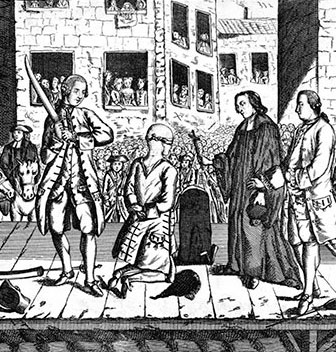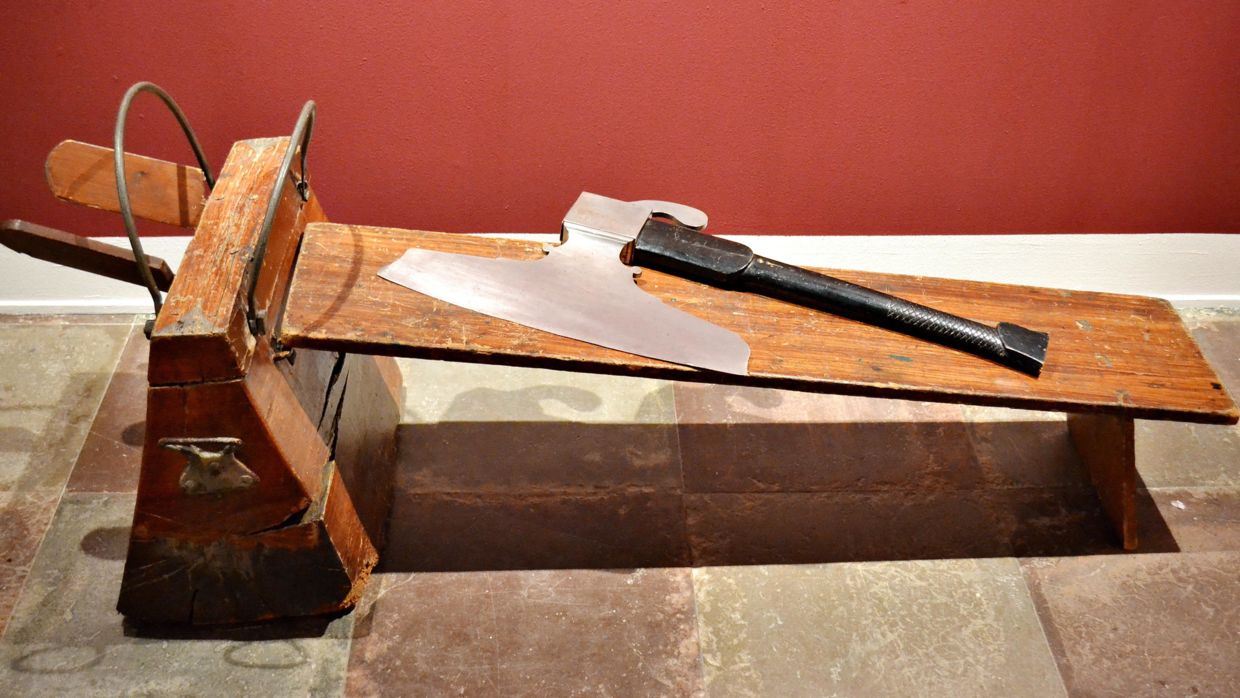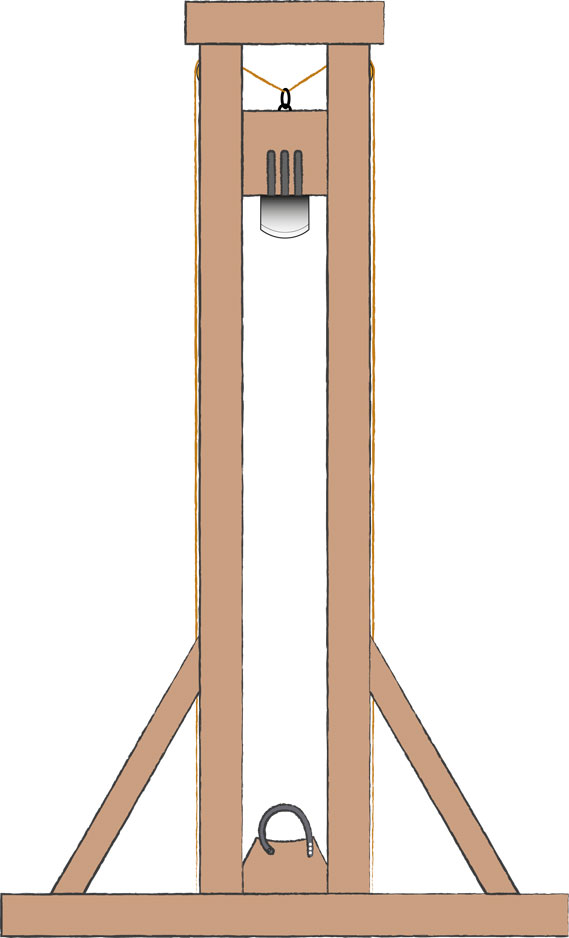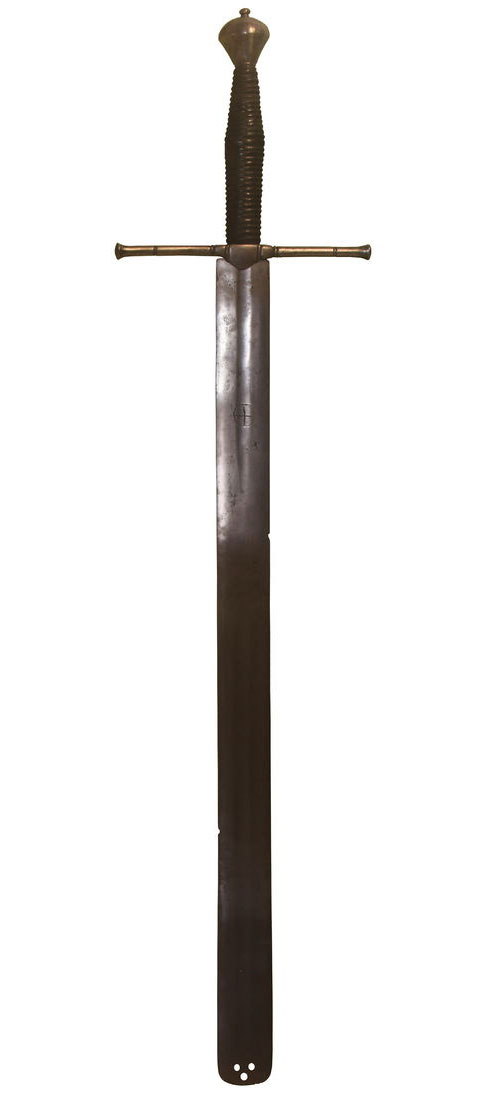Why was it necessary to use a machine for beheading?
"Every person condemned to the death penalty shall have his head severed".
Text approved by The National Assembly of France 3/6/1791
A proposal for Article 3 under Heading 1 of the Code Pénal was presented at the National Assembly on June 3, 1791, "Every person condemned to the death penalty shall have his head severed", but no method was specified, and Guillotin's original proposal for a machine for that purpose was omitted. On September 21, 1791, the law was passed. Still without specifying method. It made the executioner Sanson react:
A memorandum from the great Charles-Henri Sanson (hereditary Executioner of the High Works) to the Minister of Justice:
“In order that the execution be completed according to the requirements of the law, it is necessary that, without any resistance on the part of the victim, the executioner should be very adroit, the condemned man very composed. Otherwise, it will never be possible to complete such an execution by the sword without the risk of dangerous incidents.
“After each execution, the sword is unfit for another; it is absolutely essential that the sword, which is liable to chip, should be sharpened and whetted anew if there are several condemned persons to be executed at the same time; it is therefore necessary to have a sufficient number of swords in a state of readiness. This opens the way to very great and almost insurmountable difficulties.
“It should further be noted that swords have often broken during such executions . . .
“Consideration should be given to the possibility that, when several condemned persons are to be executed on the same occasion, the terror inspired by the execution – on account of the huge quantities of blood spread about – will cause fear and weakening in the most intrepid of those remaining to be executed. Such weaknesses will create a ruinous obstacle to the execution . . . The execution will develop into a struggle and a massacre.
“It is therefore essential,” Sanson concluded, “in order to satisfy the humanitarian opinions advanced by the National Assembly, that a means be found of immobilising the condemned man so that there can be no uncertainty in the execution . . . ”

The executon of M. de Lally in 1766
On March 17th, 1792, Dr Louis submitted his Avis motivé sur le mode de la Décolation.
“The Legislation Committee has done me the, honour of consulting me about two letters written to the National Assembly concerning the implementatlon of Article 3 under Heading 1 of the Code Pénal, which stipulates that: Every person condemned to the death penalty shall have his head severed.
In these letters, the Minister of Justice and the Directoire of the Department of Paris, in view of the representations made to them, consider it urgently necessary to determine precisely the means of carrying out the law, fearing that if a faulty method or lack of experience or maladdress rendered punishment horrible for the victim and the spectator, the people might, out of humanity, behave unjustly and cruelly towards the executioner, a contingency which it is important to avoid.
“I consider that the representations are fair and well-founded. Both experience and reason demonstrate that the method hitherto used to sever the head of a criminal exposes him to a punishment more hideous than the mere deprivation of life, which is the explicit intention of the law: to meet this wish, it is necessary that the execution be carried out instantaneously and at one stroke: all too many examples prove how difficult this is to achieve.
“One may well recall at this point what was observed at the decapitation of M. de Lally; he was on his knees, his eyes bandaged; the executioner struck on the nape of the neck; the stroke did not succeed in removing the head, nor could it have done so. The body, with nothing to prevent its falling, was thrown forward, and three or four slashes of the sword were required before the head was finally separated from the body: this hacherie, if one may coin the term, could only be contemplated with horror.
“In Germany, the executioners are more experienced owing to the frequency of this type of despatching, mainly due to the fact that persons of the female sex, no matter what their social level, are subjected to no other form of capital punishment: nonetheless, the perfect execution is not often achieved, despite the precaution taken in certain places of maintaining the victim seated in a chair.
“In Denmark, there are two positions and two instruments for decapitation. The execution which one might term honorific is carried out with a sabre; the criminal kneels, his eyes are bandaged, his hands free. If the punishment is to be ignominions, the victim, bound, is laid face downwards and his head is cut off with an axe.
“Everyone knows that cutting instruments have little or no effect when they strike perpendicularly; when one studies them under the microscope one sees that they are only more or less fine saws, that one must saw the object to be cut. One could not decapitate at a single stroke with an axe or blade of which the cutting edge was straight; but with a convex cutting edge, as in the old battle-axes, the blow dealt is not perpendicular except in the middle of the segment; the instrument, as the blade penetrates further into the parts divided, has an oblique sawing action at the sides and must therefore fulfil its function.
“When we consider the structure of the neck, of which the spinal column is the centre, being composed of a number of bones so connected that no joint can be located, it is not possible to be sure of a prompt and perfect separation if the task is entrusted to an agent likely to vary in skill for moral or physical reasons; it is absolutely necessary, if the process is to be sure, that it should depend on unvarying mechanical means of which the force and effect can also be determined. This is the View which has been adopted in England; the criminal’s body is placed face-downwards between two posts with a cross-piece at the top from which a convex axe is allowed to fall by means of a trigger onto the man’s neck. The top of the instrument should be sufficiently strong and heavy to act effectively like the ram used for pile-driving: it is well known that its force increases according to the height from which it falls.
“It is easy to have such a machine built, the effect of which will be unfailing; decapitation will be carried out in an instant, in conformity with the spirit and the intention of the new law; it will be easy to try it out on corpses or even on a living sheep. It will then be seen whether the victim’s head should be held in place by a crescent-shaped cross-piece which will encircle the neck at the base of the skull, the tips or projections of this crescent being fastened by king-pins under the scaffold: this apparatus, should it be deemed necessary, would induce no sensation and would scarcely be noticed at all.”

The block and the axe used in Denmark.
© Fængselsmuseet, Horsens Museum
How did the guillotine get its unique appearance?
There must have been a talk about slicing instead of chopping
And a talk about how to handle the sentenced person
to get him
under the blade in the fastest and most secure way,
and follow the intention of the law.
The following text is Dr Louis detailed description of the machine to M. Guidon, the carpenter accustomed to provide the State with scaffolds:
“This machine should be composed of several parts.
“1. Two parallel uprights in oak 3 metres high, joined at the top by a cross-piece and solidly mounted on a base with supporting braces at the sides and back. “These two uprights will be 30cm apart on the inside and will be 15cm thick; on the inner sides of these uprights will be longitudinal square grooves, 3cm in dept, to take the side pieces of the blade. At the top of each of these uprights, beneath the crossbar a brass pulley will be countersunk.
“2. The blade, well tempered, with a solidity of the best cleavers and made by a competent cutler, will cut on account of its convexity. This cutting edge will measure 17cm across and 15cm in height. The top of this blade will be as thick as an axe; beneath this top edge, the metal-worker will make openings so that a 15kg weight or larger can be attached to it by means of iron bands; should it prove desirable during the trial to increase the heaviness of this ”ram” the latter will be furnished with an iron ring in the middle. The blade-holder must slide down in the grooves of the uprights; its top will measure 30cm across, plus 2 square tenons projecting 2cm at the sides to fit in these grooves.
“3. A sufficiently strong and long rope will be threaded through the ring and will maintain the knife-holder under the other cross-bar; each end of this rope will be threaded from the inside over the corresponding pulley and will be fastened on the outside at the foot of these upright.
“4. The wooden block on which the victim’s neck is to be placed will be 20cm high and 10cm thick. Its base will be 30cm wide, that is to say the distance between the two uprights; a detachable bolt will pierce each upright in order to hold the said block at each side of the base. The upper part of this block will be only 20cm wide. It will have a slit across its upper surface to take the cutting-edge of the convex blade. Accordingly, the lateral inside grooves of the two uprights should not be extended lower than this slit in order that the block shall not be cut by the blade. The top of the block will be slightly scooped out so that the victim’s neck can be comfortably lodged.
“5. But to hold your head down and ensure that it is not lifted at the moment of execution, an iron crescent, in the shape of a horse-shoe with thoroughly rounded edges, should encircle the victim’s neck about the nape at the foot of the skull where the scalp ends. The extremities of this crescent, reasonably extended, should be pierced so as to be held in place by a bolt passing through the beginning of the upper part of the block which is 10cm thick. “The victim, laid faced-downwards, will have his chest supported by his elbows, and his neck will be placed without difficulty in the scooped-out part of the block. If everything has been properly arranged, the executioner standing by the machine will be able to hold the two ends of the rope supporting the blade-holder and, on his releasing them simultaneously this instrument falling down from a height will, by its weight and acceleration of speed, separate the head from the body in a twinkling of an eye.
“Should that be a few errors of details herein”, the Doctor ended, “they could easily be rectified by even the stupidest builder.
We know that the guillotine looked very different than this description by Dr. Louis. Perhaps the description was only made to get a price estimate from M. Guidon.

If Dr. Louis's design for the beheading machine was ever built, it would look like this. But this was just the first description of a machine that ended up being almost perfect within a month.
It is almost certain that Dr. Louis design was not used for the first machine. I am sure Sanson had an input on the importance of handling the victims the right way. This may have influenced the design of the bascule and the lunette, but who mentioned the pillory as a good solution in the first place? This must have been in combination with the idea of slicing instead of chopping. Which again called for the oblique blade.
“My part in the matter” Dr. Louis assured a friend, “and I consider it an act of humanity, was limited to correcting the shape of the blade and making it oblique so that it would cut cleanly and achieve its object.”
But what happened before Dr. Louis became involved?
Charles Henri Sanson had become acquainted with a German engineer named Tobias Schmidt. He was a producer of musical instruments and was very ingenious in his craft. He had sold some instruments to Sanson, who played the violin. Schmidt and Sanson occasionally played together. Sanson had told Schmidt about his confusion regarding the new law.
One night after they had played together, Schmidt hesitated for a moment and then drew a few quick lines on a piece of paper which he handed to Sanson. That was the start of the guillotine.
Schmidt told him that he had long doubted whether it was appropriate for him to have anything to do with instruments designed to kill, but that when he saw his friend's confusion, he could not resist the temptation to help him.
The man who knew what a perfect execution required together with the craftsman who could think creatively and three-dimensionally. It was thus that the guillotine came into the world. In my opinion this brainstorming session was underway before Dr. Louis became involved. That’s why it was possible to build and test the guillotine so quickly after it was decided that beheadings should be done using a machine.
These are my own assumptions of what happened in the time leading up to the first guillotine, but it is supported by Memoirs of the Sansons, from private notes and documents, 1688-1847 / edited by Henry Sanson.
You can find a pdf copy of the book from 1876 here
It will open up in a new side.
Certainly nothing officially happened until March 17, when Dr. Louis gave his evaluation of two letters previously sent to the National Assembly on the implementation of Article 3 under Heading 1 of the Code Penal. Much suggests that work was being done on the machine's design and manufacture before any economic agreements had been made. If it had only begun after April 10th when Tobias Schmidt and Roederer agreed on a price, it would not be possible to make the first test of the machine on April 11, ie the day after. April 17, just one month after Dr. Louis wrote his assessment, the machine was tested at Bicêtre. And on April 21, the new (oblique) blade was installed.
Everyone must have worked quickly and purposefully to get the first guillotine finished for the execution of Nicolas-Jacques Pelletier on April 25th 1792, on the place de Greve. (now place de l'Hotel de Ville).
At least three things made the guillotine unique:
The oblique blade, the lunette and the bascule. None of the earlier machines had these elements.

 An Executioners sword
An Executioners sword